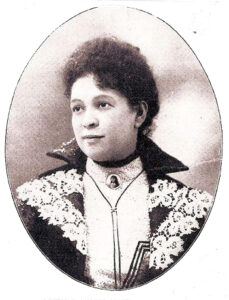Lottie Wilson Jackson
By Sophia Ward Brewer
Life Dates: b. 1854, d. January 16, 1914
Full Name: Charlotte Wilson Jackson
Birthplace: Niles, MI
Tags: Arts, Civil Rights, Community Activism, Suffrage
Lottie Wilson Jackson travelled the country promoting her art work and fighting for women’s and civil rights until her death in 1914. She also took a famous stand in 1899 in Grand Rapids.
Born in Niles, Michigan as Charlotte Wilson, Lottie was just under 10 years old when President Lincoln issued the Emancipation Proclamation, declaring the freedom of all persons held as slaves in America. She was reared in the North, but imagine the excitement of this young child at the thought of being able to move about this great country in freedom. As an adult, however, Lottie saw her dreams deferred because she was an African American woman.
Lottie Wilson Jackson fully understood the burden she carried as a woman of color. In the late spring of 1899, in fact, she spoke up at the National American Woman Suffrage Association convention in Grand Rapids about the separate coach laws being reintroduced into the South, where NAWSA had begun to travel. She proposed the following resolution, “that colored women ought not to be compelled to ride in smoking cars, and that suitable accommodations should be provided for them.” The resolution was tabled by Susan B. Anthony herself, essentially stating that women were still “helpless and disenfranchised” and could do nothing to help women of color with this issue.
Naturally, she was disappointed by the tabled resolution; and before Lottie left Grand Rapids in May of 1899, she spoke at the home of Emma Ford to the Married Ladies Nineteenth-Century Club, the oldest of the local African American women’s clubs. Then she sought further support from women and people of color by travelling the country and addressing colored audiences about the rights and specific treatment of African American women. In August of 1899, Lottie attended the three-year-old National Association of Colored Women’s convention in Chicago, where she reported on the failed resolution proposed at the national suffrage meeting a few months earlier. Minutes of the Chicago meeting record that a resolution regarding the separate coach law was endorsed and heartily supported by its members including Mary Church Terrell, the national association’s president at that time.
Lottie Wilson Jackson was also a notable artist. Having studied at the Art Institute of Chicago, in 1897 she opened an art studio in Bay City, Michigan, and became widely known for her portraits of historical subjects and notable Americans like Crispus Attucks, Frederick Douglass, and his first wife, Anna Murray Douglass. Wilson’s most famous painting was created after her move to Washington, D.C. in 1901, when she used a photograph to repaint the famous portrait of Sojourner Truth with President Abraham Lincoln, after the original had been destroyed by fire. In 1902, Wilson met President Theodore Roosevelt when she presented him with a historic memento that the “colored people of Baltimore” had given to Abraham Lincoln at his second inarugural.
Sources
This content was adapted from an article in the Grand Rapid’s Women’s Life Magazine by Sophia Ward Brewer.
More content on Lottie Wilson Jackson can be found in the Fall 2016 GGRWHC Newsletter.

